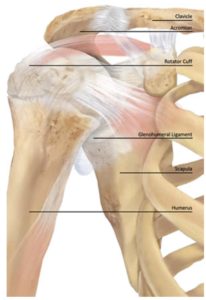
Rotator Cuff
Shoulder pain in the active patient can be due to many causes. Two general categories of shoulder problems are overuse and degeneration (wear-and-tear). Depending on age, function, severity, and patient expectations, a plan of treatment can be outlined by the orthopedist and the patient.
Most overuse-type shoulder problems are caused by tendonitis. Most-commonly, the rotator cuff is involved, though the biceps and deltoid tendons can also be affected. Tendonitis is an inflammation (and even partial tearing) of the tendon which causes pain when the muscle is used. Rotator cuff tendonitis is usually due to a bone spur or calcium deposit and most patients have pain with overhead activities and at night. Cortisone injections, anti-inflammatory medication, and physical therapy can often help. If relief is temporary or incomplete, arthroscopic surgery can remove the bone spur or calcium deposit. The prognosis for full recovery after treatment is excellent.
Degenerative changes in the shoulder affect the rotator cuff tendons and the acromioclavicular (AC) joint (end of the collar bone). AC joint arthritis can be treated with cortisone injection or a surgical procedure to remove the end of the collar bone. There is an excellent prognosis for pain relief and return of function. Degeneration and/or tearing of the rotator cuff tendons can be treated with physical therapy, debridement, or repair of the tendon. Rotator cuff repair surgery can be performed open (incision), mini-open (arthroscopic-assisted), or all arthroscopic (few small incisions). The prognosis for pain relief and restoration of function is very good but there may be some residual loss of motion or strength in severe cases.
At Pinnacle Orthopedics and Sports Medicine, Dr. Elfenbein uses advanced arthroscopic techniques to address shoulder pathology in a minimally-invasive way. This allows for faster and easier recovery and less scarring.
A detailed history, physical examination, and imaging series are essential to properly diagnose shoulder problems. Doctor and patient should discuss treatment plans to assure that patients’ desires and expectations are aligned with the proposed treatment plan.
